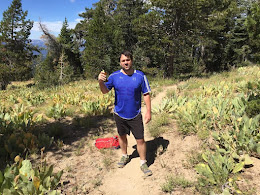
Image credit: Paul Magnanti's PCT Thru-Hike
[Added later: Endurance Guy Toby Guillette ran this section the day after I did, but the border guys apparently didn't try to scare him. I posted at the article to ask Toby what was different; maybe the one I talked to hates runners?]
Today I ran, ih, 14 miles sorta kinda on the PCT, at the southern terminus right south of Campo. Note #1: don't just roll into Campo without looking up how to get to the official start of the trail. While people in Campo were certainly nice enough, they had no idea how to get to the trailhead (with the exception of the nice docent at the museum - thanks for your help!)
Note #2: when planning a run here, do your homework and take into account illegal border activity. As I plugged up the wet-sand road from Route 94 to the border where the official marker is, a Border Patrol officer in a truck stopped me. (I've never seen so much border activity in my life as I did today in Campo). He
strongly advised me not to run on the PCT near the border because of drug and gun smugglers. It was raining off and on, and he said that activity increased during rain because the visibility is worse and some the trails and roads become impassable. Apparently he didn't think I was suitably spooked because he rolled down the back window to show me the M-16 he was carrying. "Don't run this section of the trail. Especially not today."
So I decided to stay on 94 and Buckman Springs Road for most of it, hence the sorta-kinda. It rained fairly hard while I was out but I tried to enjoy the un-San Diego-ness of cold rain at 3,000' since I know I'll be complaining about the heat inside two months. I also did a stretch on the actual trail just north of I-8 from Boulder Oaks campground up toward Laguna Mountain. That'll be the part I do next time I'm up there. On coming home, I did a search for any bad news happening on the trail and couldn't find much; maybe I should've done that ahead of time to avoid being put off by the Border guy.
 (Image credit Craig Stanton.)
(Image credit Craig Stanton.)
Two political thoughts (skip to last paragraph to avoid). First, it's extremely unfortunate that at the PCT's southern terminus access to open space meets safety considerations as a result of criminal activity; public safety is a core service of functional government and this problem is usually associated with the developing world. I found Central America frustrating for exactly this reason; lots of awesome volcanoes and forests and trails criss-crossing between villages, and lots of people in the woods who will rob and hurt you if you use those trails. In San Salvador, there are trails all over
the volcano immediately next to town, and I was strenuously warned off running any of them - although you can pay guides who used those trails as guerillas in the recently-ended Salvadorean Civil War to take you up. (And here I used to think
American Civil War re-enactments were a little strange. At least none of the guys on the field are the ones who were really killing each other during the war. By the way, here's a picture of my extremely handsome great great grandfather Jacob Caton prior to his capture at Moorefield West Virginia in 1864 in the Civil War's only sword fight.*)

The second thought is that the economic equation driving the
smuggling part of the illegal activity up there is: drugs go north, guns go south. If we decriminalize, guess who goes out of business? And civilization doesn't end when countries do this - in 2001,
Portugal decriminalized everything, and by all sorts of measures, they're better off than before. (Seriously,
click on the link. Why this isn't discussed more in the U.S. is a mystery to me. Decriminalization is the worst nightmare of those smugglers sneaking across the border in Campo because it would put them out of business overnight.)
Am I planning to run the whole thing in pieces? Probably not, but who knows; that's one of the projects I'll do if we reach
actuarial escape velocity while I can still run. (Prediction: will not happen.) Might as well knock off as many SoCal chunks as I can now because come 2013 I'll be heading back up north.
*My great great grandfather Jacob really was captured by the Confederates during a sword battle in West Virginia but he wasn't nearly this good-looking, or humble for that matter.





